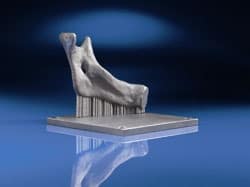Canadian science fiction author William Gibson may be one of the most influential figures in technology in the last two decades. In his 1984 novel Neuromancer, he came up with the concept of cyberspace — a shared, consensual hallucinatory space where all human data could be visualised and manipulated for fair means or foul (generally foul, in his stories). Since then, he’s been regarded as the godfather of everything from the internet itself to artificial intelligence to any illicit use of technology. But in recent years, Gibson has abandoned imagined futures as the setting for his fiction: he now works in the present, borrowing from the worlds of surveillance, high fashion and old friends of The Engineer, Festo. ‘The Future is already here,’ he explains. ‘It’s just not evenly distributed yet.’
One place where it’s becoming more evenly distributed is in schools, where plans are afoot for every school to be equipped with a 3D printer, as the BBC reports today. It’s probably safe to say that 3D printing (or additive manufacturing) is at the very cutting edge of industrial technology: most of industry still doesn’t really understand what it’s capable of and how — or when, indeed, whether — it should be used. So if the mind of industry isn’t made up yet, is the school really the best place for this technology?

Hard-pressed teachers might well argue not. Pulled in a variety of directions by controversial education reforms, the need to maintain their schools’ place in league tables and inspections, the demands of parents and employers and the needs of students, a piece of high-tech equipment they need to understand, along with the systems used to design items and operate the printer itself, is yet another big ask for a profession always under pressure. They might well be justified in asking why schools need this gadgetry, when most of industry doesn’t use it? After all, nobody’s ever demanded that all schools must have a five-axis machine tool (even though you can get them sized for a desktop these days).
There have been predictable explanations that ‘these are skills people are going to need in the workplace,’ but we can probably discount those. Nobody knows what skills with 3D printing in what sort of workplace, for the simple reason that nobody knows what sort of workplaces are going to use them, or what they’re going to use them for. In any case, school is probably not the right place to teach these sort of highly applied skills: it’s more a matter of IT confidence. This seems to be the stuff of dedicated post-school courses or even specific on-the-job training.
Where it could be of value, though, is in actually developing the technology itself. Children are natural engineers and tinkerers, and also inveterate muckers-about with software. If anyone could figure out how to make something odd and outlandish with a piece of new technology, it’s an inquisitive kid. Take a look at ingenious Amy Mather, the 14-year-old European Digital Girl of the Year title holder mentioned in that BBC article, who’s used CNC and laser cutters, 3D printers and other technology to design and build her own projects with the help of her local Fab Lab in Manchester.
What’s needed for this sort of initiative is robust, reliable equipment and tutorial materials for teachers and students alike, similar to those used which got millions of Acorn’s BBC Microcomputers into schools in the 80s. That initiative led directly to the dominance of young British programmers in the computer games and CGI imagery industries — both massive contributers to the national economy and attractive industries to work in — and, through patronage of Acorn, to the development of the RISC microprocessor which is behind the success of ARM Holdings, the UK’s premier computing company.
So, by all means get 3D printers into schools. It’s just the kind of inspiring technology, just on the edge of being a toy, that could find us on the rising edge of a technological revolution in a few decades’ time. To bring us back to the undistributed future of Mr Gibson, one of his most celebrated phrases is ‘The street finds its own uses for things.’ So does the schoolroom.





Glasgow trial explores AR cues for autonomous road safety
They've ploughed into a few vulnerable road users in the past. Making that less likely will make it spectacularly easy to stop the traffic for...